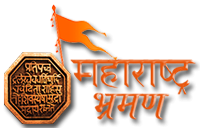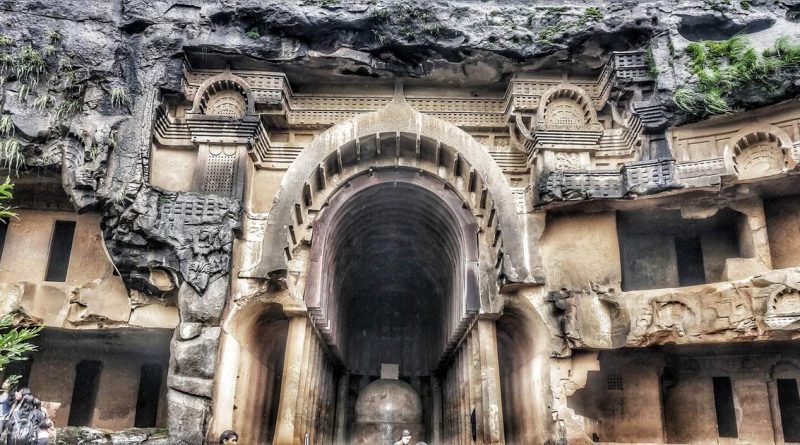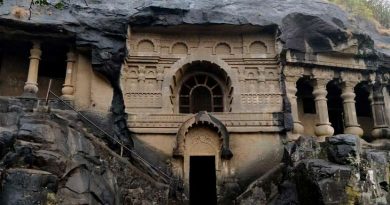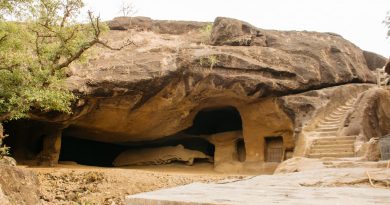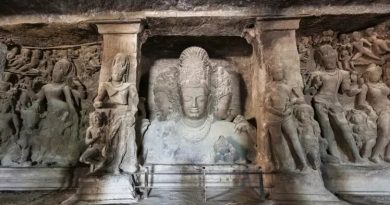Bhaja caves
Bhaja Caves are a group of 22 rock-cut caves dating back to 200 BC located at Maval, near Lonavala, Maharashtra.The caves are located 400 feet above the Bhaja Village. The Bhaja Caves are on a major trade route of the past that ran from the Arabian Sea eastward into the Deccan region, the division between North India and South India. The inscriptions and cave temple are protected as a National Monument, by the Archaeological Survey of India vide Notification No. 2407-A. This is one of the prominent centers of Hinayana Buddhist sect. The caves have a number of stupas in open space as one of their significant features. These caves are notable for their wooden architecture.
Architecture:
The Bhaja Caves share architectural design with the Karla Caves. The most impressive monument is the large shrine — chaityagriha — with an open, horseshoe-arched entrance; according to the Archaeological Survey of India, the chaityagrha is the most prominent aspect of the caves, and one of the earliest of the type. The chaitrya has unique reliefs from Indian mythology. Other caves have a nave and aisle, with an apse containing a solid tupa and the aisle circling round the apse, providing the circumambulation path.
Chaitygraha has some Buddha images. A cistern inscription shows the name of a donor, Maharathi Kosikiputa Vihnudata, from the 2nd century AD. A wooden beam records two more inscriptions datable to 2nd century B.C., which indicates caves have been there for at least 2200 years. Eight inscriptions are found in the caves, some giving the name of the donors.
The sculptures feature elaborate headdress, garlands, and jewellery; they might have originally been painted in bright colors but later covered with plaster. Characteristic for early Buddhism, initially the caves had symbolic Buddha representation. After 4 A.D. Buddha was painted in physical form as well.
Near the last cave is a waterfall which, during the monsoon season, has water that falls into a small pool at the bottom. These caves also provide important proof regarding the history of the Tabla, an Indian percussion instrument, since carvings from 200 BCE show a woman playing tabla and another performing a dance.
Stupas:
A notable part of the monument is a group of 14 stupas, five inside and nine outside an irregular excavation. The stupas are relics of resident monks, who died at Bhaja, and display an inscription with the names of three monks, Ampinika, Dhammagiri and Sanghdina. One of the stupa shows Stavirana Bhadanta means the venerable reverend inscribed on it. The stupa particulars show the name of the monks and their respective titles. The stupas have been carved very elaborately and two of them have a relic box on their upper side. Names of monks have been titled with Theras.
Caves:
Cave VI
It is irregular vihara, 14 feet square, has two cells on each side and three on back side. The chaitya window is ornamental all over cell doors. ploughman’s wife, Bodhi, gifted this Vihara as her name is inscribed on cell door.
Cave IX
Rail pattern ornament, broken animal figures, verandah is on frontal side. It is similar to Cave VIII at Pandavleni Caves.
Cave XII
Chaitya is 26 feet 8 inches wide and 59 feet long, with semi-circular apse at back, and having aisle 3 feet 5 inches wide, separated from the nave by 27 octagonal shaft. 11 feet 4 inches height. The dogoba is 11 feet diameter at the floor. This resembles the Kondana Caves. The pillar has 7 different symbols of Buddha shown in floral form, buds, leaves, fan.
Cave XIII
This seems to be destroyed may be it would have been wood architect during ancient times. It is 30 feet long and 14.5 feet deep. Rail pattern is observed, a few cells at the back and a bolt door system are observed here.
Cave XIV
This cave is facing towards northern side 6 feet 8 inches wide and 25.5 feet deep, with 7 cells. Stone benches, square windows, stone beds—are observed in the cells.
Cave XV
It can be reached by stairs to the south of Cave XIV. It is a small vihara 12.5 wide and 10 feet deep. It has two semi-circular niches and a bench on right side.
Cave XVI
This façade has 3 Chaitya arches and the rail pattern.
Cave XVII
It is a small vihara 18.5 feet long and 12.5 deep, with 5 cells, one of the cell has a bench in it. It has two inscriptions in it one of which is damaged. Cell door inscription describes “the gift of cell from Nadasava, a Naya of Bhogwati.” One more inscription over two wells in one recess describes “a religious gift of cistern by Vinhudata, son of Kosiki, a great warrior.”
Cave XIX
It is a monastery with a verandah. The door has guardian figures on both sides. This cave has Surya riding a chariot and Indra riding on an elephant.
How to reach:
How to go to Bhaja caves from Pune (magarpatta city): Bhaja caves are very easy to locate , as the exit is located right on the old Pune-Mumbai highway. Take the Nh4 (old mumbai-pune highway) towards Mumbai, few kilometres (6-7) before lonavala, you should see an exit on the left towards Bhaja/Malavali (and one on the right towards Karla caves). Take the left, you should reach Malavali village (there is a railway crossing to cross – a wait not more than 10 minutes). 2 kms from Malvali, you would reach the base village of Bhaja, where ample parking is available. On any monsoon day, you would see lot of trekking/walking grps walking towards Bhaja from Malvali railway station, but the likes of me drive over as much we can and then walk the remaining distance. On the day i went, the old highway was blocked because of Palkhi, so i was forced to take the expressway. So, if you too have to take the expressway for some reason, drive upto Lonavala (central point), take almost a U-turn onto the old highway going towards Pune, drive for 6-7 kilometres and then turn right towards Bhaja. During the non-monsoon seasons, there is a shortcut from behind the food court on the expressway (before lonavala) to reach the malvali village road without having to go to Lonavala and then come back.
